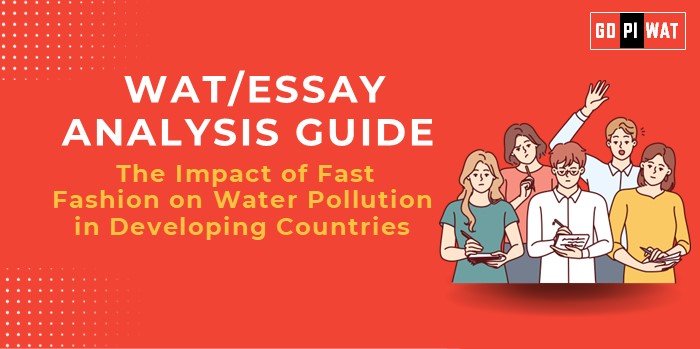📋 Written Ability Test (WAT)/Essay Analysis Guide: The Impact of Fast Fashion on Water Pollution in Developing Countries
🌐 Understanding the Topic’s Importance
Fast fashion’s water pollution crisis embodies a larger dilemma of economic growth versus environmental sustainability, especially in developing countries where governance and consumer awareness are often lacking.
📝 Effective Planning and Writing
- Time Allocation:
- Planning: 5 minutes
- Writing: 20 minutes
- Review: 5 minutes
- Word Count Distribution (300 words):
- Introduction: 50 words
- Body: 200 words
- Conclusion: 50 words
📚 Introduction Techniques for Essays
- Contrast Approach: “While fast fashion enables affordable clothing, its production pollutes rivers like the Buriganga and Citarum, leaving communities struggling with toxic water.”
- Solution-Based Approach: “Transitioning the fast fashion industry to sustainable practices could save billions of liters of water annually, preserving ecosystems and livelihoods.”
📊 Structuring the Essay Body
- Achievements: Highlight successes like Levi’s water-efficient jeans production.
- Challenges with Comparative Analysis: Discuss weak enforcement in India and Bangladesh, contrasting with stringent EU policies.
- Future Outlook: Recommend transitioning to circular fashion and investing in waterless dyeing technologies.
📈 Concluding Effectively
- Balanced Perspective Conclusion: “The fast fashion industry’s economic benefits cannot justify its environmental toll. Collaborative solutions are essential for a sustainable future.”
- Global Example Conclusion: “Learning from the EU’s eco-friendly textile policies, developing countries must enforce regulations to protect water resources.”
🔑 Recommendations for Sustainable Progress
- Enforce wastewater treatment mandates.
- Promote consumer awareness about eco-friendly brands.
- Invest in sustainable innovation like bio-based dyes.
💡 Sample Short Essays
- Balanced Perspective: “Fast fashion’s affordability and global reach come at an environmental cost, particularly to water bodies in developing nations. Tackling this issue requires collective action by governments, industries, and consumers.”
- Solution-Oriented: “Technologies like waterless dyeing and recycled fibers hold the key to sustainable fast fashion. Brands must lead by example to save precious water resources.”
- Global Comparison: “While the EU enforces strict water management in textiles, developing countries face challenges in regulation enforcement, underscoring the need for global cooperation.”


